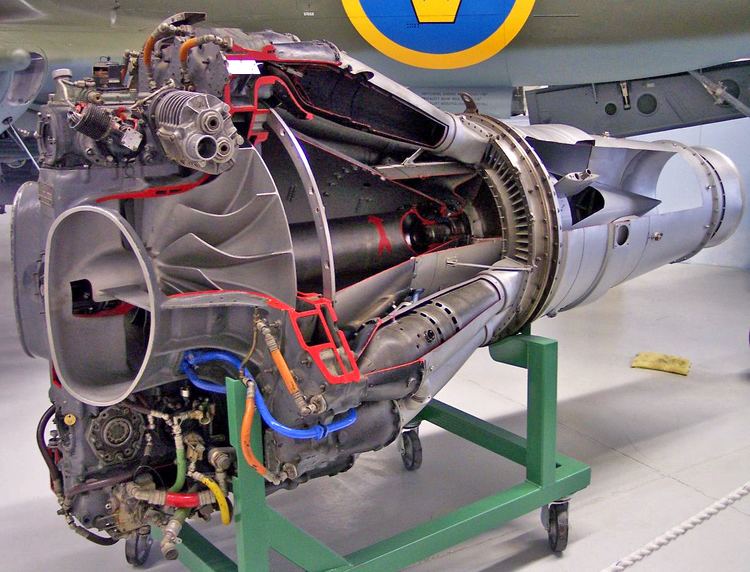 | ||
The de Havilland Goblin, originally the Halford H-1, is an early turbojet engine designed by Frank Halford and built by de Havilland. The Goblin was the second British jet engine to fly, after the Power Jets W.1, and the first to pass a type test and receive a type certificate issued for an aircraft propulsion turbine.
Contents
- Design and development
- Variants
- Aircraft applications
- Alternative applications
- Engines on display
- Survivors
- Specifications DH Goblin II DGn 27
- General characteristics
- Components
- Performance
- References
Although it was conceived in 1941 it remained unchanged in basic form for 13 years by which time it had evolved to the Mk. 35 export version.
The Goblin was the primary engine of the de Havilland Vampire, and was to have been the engine for the F-80 Shooting Star (as the Allis-Chalmers J36) before that design switched engines due to production delays. The Goblin also powered the Saab 21R, Fiat G.80 and de Havilland Swallow. The Goblin was later scaled up as the larger de Havilland Ghost, with the model numbers continuing from the last marks of the Goblin.
Design and development
Design of the engine was carried out by Frank Halford at his London consulting firm starting in April 1941. It was based on the basic design pioneered by Frank Whittle, using a centrifugal compressor providing compressed air to sixteen individual combustion chambers, from which the exhaust powered a single-stage axial turbine. Compared to Whittle designs, the H-1 was "cleaned up" in that it used a single-sided compressor with the inlet at the front, and a "straight through" layout with the combustion chambers exhausting straight onto the turbine. Whittle's designs such as the Power Jets W.2 used a "reverse flow" layout that piped the hot air back to the middle of the engine, in order to "fold" it and reduce its length. Although it eliminated the Whittle-style "folding", the Goblin was still a very compact design.
The H-1 first ran on 13 April 1942 and quickly matured to produce its full design thrust within two months. It first flew on 5 March 1943 in the Gloster Meteor, and on 26 September in the de Havilland Vampire. It was around this time that de Havilland purchased Halford's company and set him up as the chairman of the de Havilland Engine Company, with the engine name changing from H-1 to "Goblin", while the new H-2 design became the "Ghost" - de Havilland jet and rocket engines were all named after spectral apparitions.
In July 1943, one of the two H-1s then available (actually the spare engine intended as a backup for the one installed in the Vampire prototype) was sent to the United States, where it was selected to become the primary engine of the Lockheed P-80 Shooting Star. This engine was fitted to the prototype P-80, which first flew on 9 January 1944. The engine was later accidentally destroyed in ground testing, and was replaced by the only remaining H-1 from the prototype Vampire. Allis-Chalmers was selected to produce the engine in the US as the J36, but ran into lengthy delays. Instead, the Allison J33, developed by General Electric as the I-40 (their greatly improved 4,000 lbf (18 kN) version of the J31, itself based on Whittle's W.1), was selected for the production P-80A.
Variants
Aircraft applications
Alternative applications
Engines on display
Goblin engines are preserved and on display at several museums including:
Survivors
As of June 2011, two Goblin powered de Havilland Vampires remain airworthy on the British register.
As of December 2014, two Goblin powered de Havilland Vampires remain airworthy in North America. N115DH is owned by the World Heritage Air Museum. and C-FJRH is operated under the Jet Aircraft Museum in Ontario, Canada.
As of November 2015, three Goblin powered de Havilland Vampires remain airworthy in South Africa. Serial number 276 and 277 are in the SA Air Force Museum and the third is at Wonderboom Airport.
Specifications (D.H Goblin II D.Gn 27)
Data from Smith
